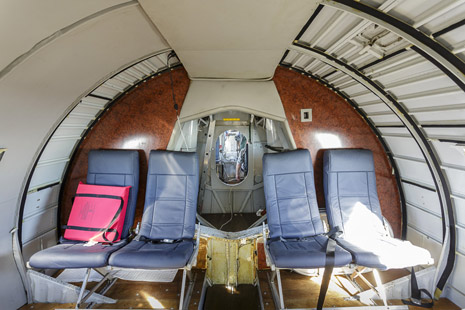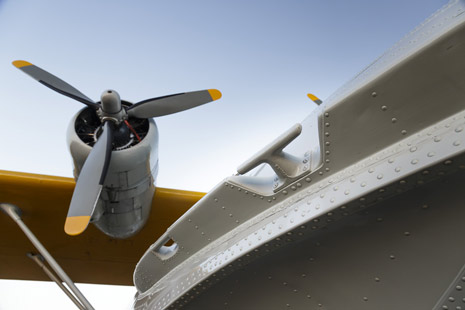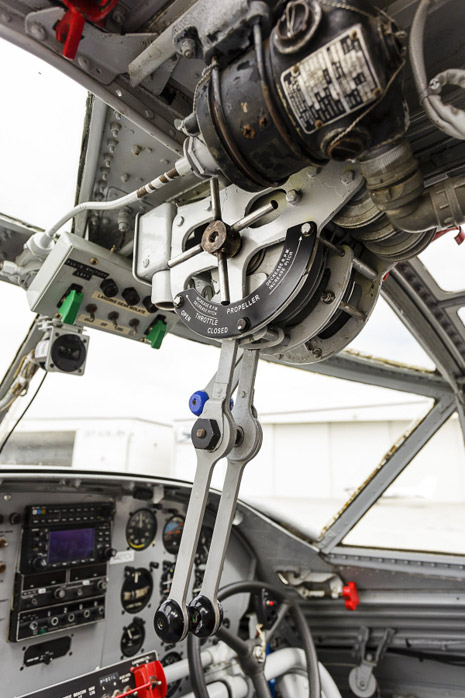Consolidated PBY–5a Catalina: Stand up and salute
Downed airmen owe their lives to the PBY

Airplanes given the most creditfor winning World War II include such famous warriors as the P–51 Mustang, the B–29 Superfortress, and the Supermarine Spitfire. A not-so-glamorous airplane, the Consolidated PBY–5A Catalina, also deserves inclusion in this elite group—not because it had single-purpose supremacy, but because it had such multifaceted utility.
The PBY is heralded for its yeoman work in search-and-rescue operations, especially by the thousands of sailors and downed airmen who owe their lives to one.
A heavy cruiser, the USS Indianapolis, was sunk by Japanese torpedoes in the Philippine Sea on July 30, 1945, leaving 900 men struggling to survive in shark-infested waters without food, drinking water, or rafts. A scream piercing the air meant that another sailor had been taken down by shark. The ship was not missed, and when the survivors were accidentally discovered four days later, only 316 remained alive. First to arrive on the scene was Lt. Adrian Marks, flying a PBY. His landing in the churning sea was so hard that rivets popped from the hull. Throughout that night, he and his crew valiantly pulled 56 sailors from the bloodied water. When the fuselage was full, survivors were hauled onto the wings. Men were prevented from falling off by tying them in place with parachute cord. All were rescued the next day by a destroyer escort; the PBY had to be scuttled.
An Army pilot rescued by a PBY on a different occasion said, “When I see a PBY, I stand up and salute.”
The Catalina’s remarkable range made it effective for patrol, enabling PBY pilots to discover the Japanese strike and invasion forces approaching Midway Island in June 1942. A PBY was first to torpedo a Japanese ship at the onset of the Battle of Midway. This was the turning point of the Pacific War, and resulted in the sinking of four of the six Japanese aircraft carriers responsible for the attack on Pearl Harbor six months earlier.
Later in the war, a group of PBYs was painted flat black, dubbed the Black Cats, and used to locate and attack Japanese shipping at night. They were effective in attacking ships attempting to land reinforcements at Guadalcanal. In the European theater, a PBY crew found the German battleship, Bismarck, leading to its destruction.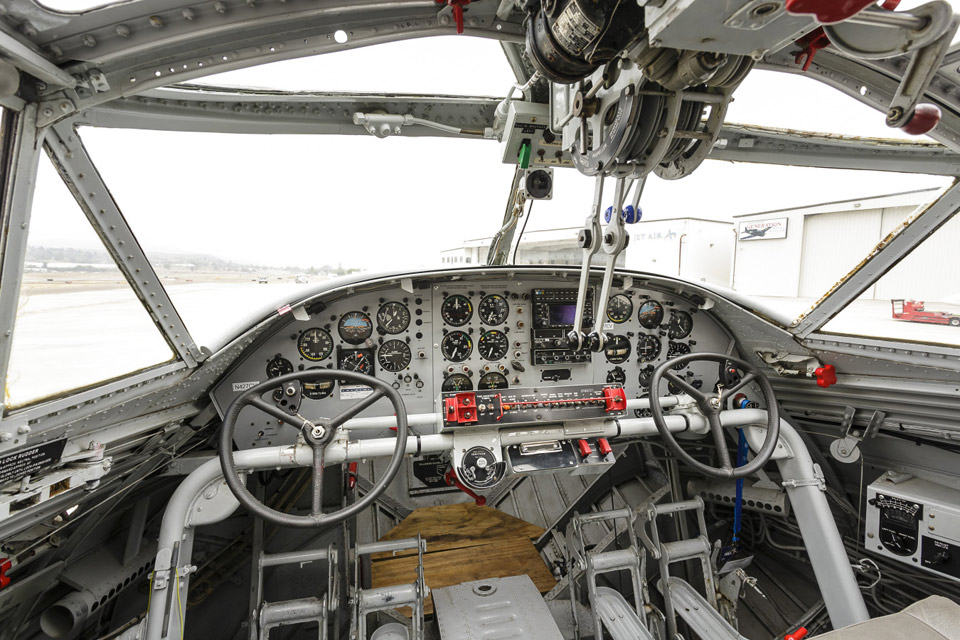
When retracted, the electrically operated floats form the wing tips, and their struts blend into the undersides of the wings. A Land-Sea switch is used to ensure that a warning light indicates correctly prior to landing. With the switch in the Land position, the light glows red unless the landing gear has been extended and the floats are retracted, and vice-versa with the switch in the Sea position.
Some say that the Pig Boat was so slow that navigators needed calendars more than they did chronographs. Typical true airspeed is 115 knots with a fuel burn of 86 gph at 5,000 feet. Maximum endurance is more than 20 hours. The Navy described the PBY as “breathlessly hot in the tropics and achingly cold in the Arctic, and at once hated and loved. In spite of her shortcomings, the rugged PBY rarely failed to bring her crew home despite all that the enemy or the weather could muster to bring her down.”
The PBY was the first production airplane with wet wings and has remarkable range, 2,338 nm on a no-reserve fuel capacity of 1,750 gallons. In the war, Qantas Empire Airways operated “Double Sunrise Flights,” so-called for the obvious reason. These PBYs carried VIPs and mail nonstop between Perth, Australia, and Galle, Ceylon—3,592 nm that required 33 hours, a record for an airline flight using an airplane. Average flight time was 28 hours.
The design leading to the PBY was the Consolidated XPY-1, which had four open cockpits and first flew in 1929. The prototype PBY first flew on March 28, 1935. The PBY–1, –2, –3, –4, and –5 were long-range flying boats that operated strictly from water. Beaching gear was needed to roll them ashore and back into the water. The primary difference between the PBY–5 and its predecessors is that waist-gun blisters replaced sliding hatches. The PBY–5 morphed into the PBY-5A with the addition of tricycle landing gear. This amphibious flying boat first flew in 1939 and was the largest of its day. The PBY also became the world’s most successful flying boat. More were built (3,272) than all others combined, a standing record. Almost half of these were amphibians.
The mere sight of a PBY can evoke a visceral sensation and cause us to fantasize about roaming the world in a Catalina and splashing or touching down wherever our wanderlust leads. It was this romanticized notion of an airborne yacht that inspired Southern California Aircraft to develop a postwar conversion of the PBY called the Landseaire. This luxuriously appointed amphibian comfortably slept eight—surely this included a mechanic—and had a full galley. Two 14-foot dinghies (for getting ashore) fit snugly under the wings (where bombs and torpedoes had hung) and were raised and lowered by a built-in electric hoist.
A pilot since he was 16, Slattery is fascinated with history, especially World War II in general and the Pacific Theater in particular. He founded the Greatest Generation Naval Museum with the intention of “humanizing the Greatest Generation in a way that inspires young people to rise above whatever obstacles they might encounter during whatever pursuits they might undertake.”
The museum thus far has 42 warbirds that have been or are being restored. Some are quite rare, and all are kept airworthy.
With respect to the PBY, Slattery likens it to a hit song. “You throw hundreds of tunes against a wall, and one becomes a hit. It’s the same in aviation. There can be hundreds or thousands of designs, and once in a while the magic happens. You have a P–51, a Spitfire, or something else very special, like a PBY.”
The engines are mounted unusually close to one another. The good news is that this eases directional control following an engine failure. The bad news is that it reduces the effectiveness of differential power for steering on water. When desired, one main landing-gear leg may be lowered in the water to help tighten a turn in that direction. The hydraulically operated landing gear also is extended in the water for taxiing up a ramp onto land. Like most multiengine seaplanes, the PBY does not have a water rudder. Differential power instead is used for steering.
Wing flaps? There are none. Systems-wise, the PBY is a relatively simple airplane. Cowl flaps are operated with hand cranks.
You steer the Cat onto the runway using differential braking. Differential power is then used initially to track the centerline during takeoff while advancing the throttles to 48 inches and 2,700 rpm. (The 1,200-horsepower Pratt & Whitney R-1830-92 radial engines are supercharged.) The rudder soon becomes effective and the big boat lifts off at a surprisingly low 70 knots.
The airplane goes from looking almost ungainly on the ground to somewhat graceful in the air, which belies its handling qualities. The PBY has heavy flight controls. To fly it, you use muscles you never knew you had. The control wheel rotates 1.5 full turns from one limit to the other, or three-fourths of a turn from neutral to full. You don’t just move the wheel; you wrestle with it. Castillo says, “It is like driving a cement truck in soft sand without power steering.”
It’s not bad in smooth air, but in turbulence the Cat wallows all over the sky. It seems that if you’re not always moving the controls, you’re doing something wrong. At times, the airplane inexplicably yaws one way or the other, and you admonishingly shove a rudder pedal as if to say, “Don’t do that!” The airplane seems to have a mind of its own and doesn’t always do what you expect, as though a sadistic simulator instructor is messing with you. You anticipate that because the ailerons are so far outboard there would be lots of adverse yaw effect, and there is. Other than being oddly unstable at times, a beast to maneuver, and underpowered, it is marvelously capable and, strange as it may seem, fun to fly. It puts a smile on your face. It is difficult, though, to imagine young men going to war in these aircraft.
An approach to stall is signaled by a slight tail shake, which increases as the stall deepens. The humongous wing makes the stall benign—typically a nose-high, mushing descent from which recovery requires only releasing back pressure.
The parasol wing is high above the fuselage. This provides outstanding cockpit visibility and makes the P-boat particularly effective for search and patrol missions. Such a high wing also helps to protect the propellers from damaging sea spray.
The pylon supporting the wing was where the flight engineer sat. He operated the engines, propellers, floats, and landing gear. Sight gauges indicated fuel quantity. Civilian PBYs are modified to eliminate the engineer by relocating his controls and instruments to the cockpit. His seat is still there, and riding in the pylon and peering out the small side windows offers a unique perspective.
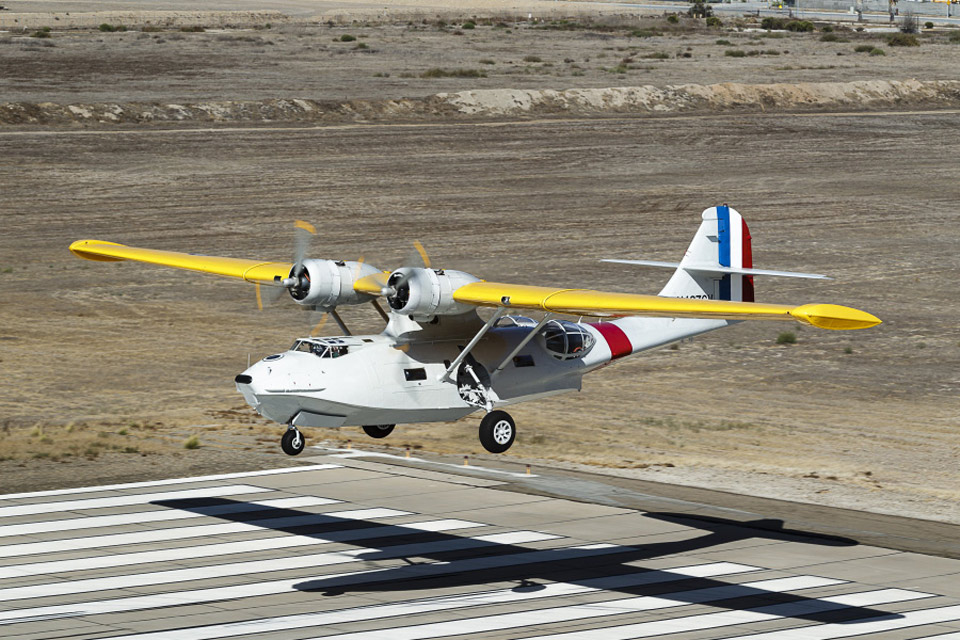
Originally intended for defending the coasts of the United States, PBYs also served as bombers, sub killers, recon platforms, convoy escorts, and liaison transports. Pilots affectionately referred to them as Cats, P-boats, Pig Boats, and Dumbos.
The designation PBY meant that the aircraft was a patrol bomber built by Consolidated Aircraft. The final letter of Navy aircraft designations represented the manufacturer. Y stood for Consolidated, F for Grumman, and so forth. Consolidated merged with Vultee Aircraft in 1943 to form Consolidated Vultee, or Convair.
Most PBYs were built in San Diego, but the Catalina on these pages, N427CV, was manufactured under license by Canadian Vickers in 1945. It served in the Royal Canadian Air Force and eventually became a fire bomber. It worked its way to Europe and then South Africa, where it wound up dilapidated and parked in the weeds at Johannesburg’s Rand Airport.
The airplane was discovered and rescued by James Slattery, a self-described “aviation enthusiast” from Fort Lauderdale, Florida, who financed a meticulous restoration. “I wanted the airplane for our museum, the Greatest Generation Naval Museum at Gillespie Field in San Diego.”
The airplane was certified for civilian use and flown to San Diego by Bob Franicola and Mike Castillo. The 12,000-mile journey began Christmas Day 2012, took 125 hours of flight time, and ended 16 days later. Franicola said that the airplane performed flawlessly. San Diego seems an appropriate home for a PBY. Most were built near the edge of San Diego’s Lindbergh Field, and Naval Base San Diego is home of the Pacific Fleet.
Slattery’s PBY–5A is painted in prewar colors. Even though a 1930s design, it presents an intriguing and appealing appearance. The hull and rear fuselage are an artful blend of nautical and aeronautical form and function. It is all metal, except that the aft portions of the wings and all control surfaces are fabric-covered.
You board a PBY from land or water by climbing a small ladder and entering through a waist blister. The fuselage has five compartments separated by bulkheads with watertight doors. A military PBY had a crew of eight: two pilots, a flight engineer, a bow gunner/bombardier, two waist gunners, a navigator, and a radio operator. This PBY, though, accommodates 15—two pilots and 13 passengers. Seats of choice in the cabin are by the blisters, which may be open in flight and are wonderful places from which to cast a rod when on water.
Like most flying boats, throttles and propeller controls are overhead to simplify routing control cables to the engines. A large button for each engine on the overhead panel is depressed to feather a “useless propeller.”
SPEC SHEET
Consolidated PBY–5A Catalina
Specifications
Powerplants | Two 14-cylinder Pratt & Whitney R-1830-92 Twin Wasp 1,200-hp ea
Recommended TBO | 1,200 hr
Propeller | Hamilton Standard Hydromatic constant speed, 11 ft 6 in diameter
Length | 63 ft 11 in
Height | 21 ft 1 in
Wingspan | 104 ft 0 in
Wing area | 1,400 sq ft
Wing loading | 25.3 lb/sq ft
Power loading | 14.8 lb/hp
Lift-to-drag ratio | 11.9 to 1
Crew (wartime) | 7-9
Empty weight, as tested | 21,000 lb
Max gross weight | 35,420 lb
Max gross weight (Standard category) | 28,500 lb
Useful load, as tested | 14,420 lb
Payload w/full fuel, as tested | 3,920 lb
Max takeoff weight | 35,420 lb
Max takeoff weight (Standard category) | 28,500 lb
Max landing weight | 35,420 lb
Max landing weight (Standard category) | 28,500 lb
Fuel capacity | 1,750 gal (all usable)
Oil capacity, ea engine | 76 gal
Performance
Takeoff distance, ground roll, land | 1,750 ft
Takeoff distance over 50-ft obstacle, land | 3,590 ft
Rate of climb, sea level | 610 fpm
Max level speed, sea level | 157 kt
Cruise speed/endurance w/45-min rsv, std fuel (fuel consumption, both engines) 7,000 ft
@ 68% power, best economy | 109 kt/18.5 hr (516 pph/86 gph)
Service ceiling | 15,800 ft
Landing distance over 50-ft obstacle, land | 1,290 ft
Landing distance, ground roll, land | 2,800 ft
Limiting and recommended airspeeds
VMC (min control w/one engine inoperative, unofficial) | 80 KIAS
VX (best angle of climb) | 70 KIAS
VY (best rate of climb) | 85 KIAS
VTURBULENCE (max in extreme turbulence) | 110 KIAS
VLE (max gear extended) | 120 KIAS
VLO (max gear operating)
Extend | 120 KIAS
Retract | 120 KIAS
VFLOATS (max operate) | 120 KIAS
VNO (max structural cruising) | 121 KIAS
VNE (never exceed) | 173 KIAS
VS1 (stall, clean) | 58 KIAS
VS1 (stall, floats and gear down) | 63 KIAS
Extra
The Pratt & Whitney R-1830 engines are the most produced aviation engines ever built. These twin-row, 14-cylinder radial engines were also used on the B–24 Liberator, the Douglas DC–3, the Grumman F4F Wildcat, and others.
All specifications are based on manufacturer’s calculations. All performance figures are based on standard day, standard atmosphere, sea level, military gross weight conditions unless otherwise noted.
